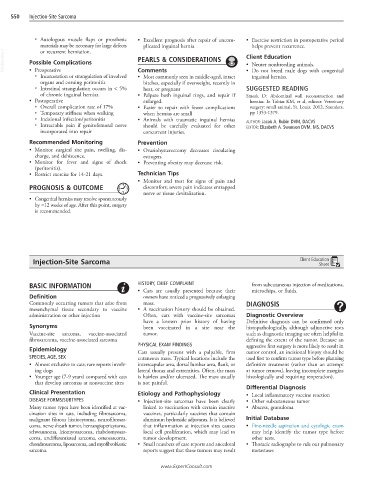Page 1104 - Cote clinical veterinary advisor dogs and cats 4th
P. 1104
550 Injection-Site Sarcoma
○ Autologous muscle flaps or prosthetic • Excellent prognosis after repair of uncom- • Exercise restriction in postoperative period
materials may be necessary for large defects plicated inguinal hernia helps prevent recurrence.
VetBooks.ir Possible Complications PEARLS & CONSIDERATIONS Client Education
or recurrent herniation.
• Neuter nonbreeding animals.
• Preoperative
○ Incarceration or strangulation of involved Comments • Do not breed male dogs with congenital
inguinal hernias.
• Most commonly seen in middle-aged, intact
organs and ensuing peritonitis bitches, especially if overweight, recently in
○ Intestinal strangulation occurs in < 5% heat, or pregnant SUGGESTED READING
of chronic inguinal hernias. • Palpate both inguinal rings, and repair if Smeak D: Abdominal wall reconstruction and
• Postoperative enlarged. hernias. In Tobias KM, et al, editors: Veterinary
○ Overall complication rate of 17% • Easier to repair with fewer complications surgery: small animal, St. Louis, 2012, Saunders,
○ Temporary stiffness when walking when hernias are small pp 1353-1379.
○ Incisional infection/peritonitis • Animals with traumatic inguinal hernias AUTHOR: Jacob A. Rubin DVM, DACVS
○ Intractable pain if genitofemoral nerve should be carefully evaluated for other EDITOR: Elizabeth A. Swanson DVM, MS, DACVS
incorporated into repair concurrent injuries.
Recommended Monitoring Prevention
• Monitor surgical site pain, swelling, dis- • Ovariohysterectomy decreases circulating
charge, and dehiscence. estrogen.
• Monitor for fever and signs of shock • Preventing obesity may decrease risk.
(peritonitis).
• Restrict exercise for 14-21 days. Technician Tips
• Monitor and treat for signs of pain and
PROGNOSIS & OUTCOME discomfort; severe pain indicates entrapped
nerve or tissue devitalization.
• Congenital hernias may resolve spontaneously
by ≈12 weeks of age. After this point, surgery
is recommended.
Injection-Site Sarcoma Client Education
Sheet
BASIC INFORMATION HISTORY, CHIEF COMPLAINT from subcutaneous injection of medications,
• Cats are usually presented because their microchips, or fluids.
Definition owners have noticed a progressively enlarging
Commonly occurring tumors that arise from mass. DIAGNOSIS
mesenchymal tissue secondary to vaccine • A vaccination history should be obtained.
administration or other injection Often, cats with vaccine-site sarcomas Diagnostic Overview
have a known prior history of having Definitive diagnosis can be confirmed only
Synonyms been vaccinated in a site near the histopathologically, although adjunctive tests
Vaccine-site sarcoma, vaccine-associated tumor. such as diagnostic imaging are often helpful in
fibrosarcoma, vaccine-associated sarcoma defining the extent of the tumor. Because an
PHYSICAL EXAM FINDINGS aggressive first surgery is more likely to result in
Epidemiology Cats usually present with a palpable, firm tumor control, an incisional biopsy should be
SPECIES, AGE, SEX cutaneous mass. Typical locations include the used first to confirm tumor type before planning
• Almost exclusive to cats; rare reports involv- interscapular area, dorsal lumbar area, flank, or definitive treatment (rather than an attempt
ing dogs lateral thorax and extremities. Often, the mass at tumor removal, leaving incomplete margins
• Younger age (7-9 years) compared with cats is hairless and/or ulcerated. The mass usually histologically and requiring reoperation).
that develop sarcomas at nonvaccine sites is not painful.
Differential Diagnosis
Clinical Presentation Etiology and Pathophysiology • Local inflammatory vaccine reaction
DISEASE FORMS/SUBTYPES • Injection-site sarcomas have been clearly • Other subcutaneous tumor
Many tumor types have been identified at vac- linked to vaccination with certain inactive • Abscess, granuloma
cination sites in cats, including fibrosarcoma, vaccines, particularly vaccines that contain
malignant fibrous histiocytoma, neurofibrosar- aluminum hydroxide adjuvants. It is believed Initial Database
coma, nerve sheath tumor, hemangiopericytoma, that inflammation at injection sites causes • Fine-needle aspiration and cytologic exam
schwannoma, leiomyosarcoma, rhabdomyosar- local cell proliferation, which may lead to may help identify the tumor type before
coma, undifferentiated sarcoma, osteosarcoma, tumor development. other tests.
chondrosarcoma, liposarcoma, and myofibroblastic • Small numbers of case reports and anecdotal • Thoracic radiographs to rule out pulmonary
sarcoma. reports suggest that these tumors may result metastases
www.ExpertConsult.com

